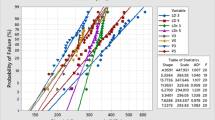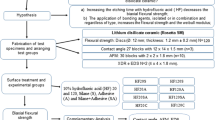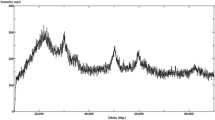The mechanical behavior and failure mode of multilayered bonded and non-bonded glass-ceramic structures after long-term water-aging is relevant considering how widely used these ceramics are in many fields. This work is focused on ceramic structures used in dentistry. The objective here was to determine the fracture load of ceramic structures not bonded and bonded to a dentin analog material (G10) using low (L) and high-viscosity (UH) dual-cured resin cements (C). Porcelain (P) disks were tested whether bonded or not bonded to G10, as follows: a) P – control group, b) PHF – acid etched, c) P·CL – HF and coated with CL, d) P·CUH – HF and coated with CUH, e) P·CL·G10 – HF and bonded to G10 using CL, and f) P·CUH·G10 – HF and bonded to G10 using CUH. The groups bonded to G10 were stored in deionized water for 24 h, 1, 3, and 6 months. The fracture load was examined using Weibull statistics. The Weibull modulus (m) for group P was similar to that of PHF and significantly higher than for P·CL and P·CUH. P·CL showed higher m than P·CUH. As for the characteristic fracture loads (F0), P and PHF showed statistically similar values that were significantly higher than those obtained for P·CL and P·CUH. For P·CUH·G10, there was no effect of storage time on both the F0 and m. For P·CL·G10, storage time only caused significant changes in F0. After aging, there was no change in the mechanical behavior of the porcelain structures bonded to G10 using CUH. There was a decrease in F0 over time when CL was used. These results reveal that the viscosity of the resin cement plays an important role in the mechanical behavior of the bonded porcelain structures. Overall, ceramic structures bonded using a high-viscosity dual-cured resin cement seems to present better performance over time.





Similar content being viewed by others
References
J. R. Kelly, P. Rungruanganunt, B. Hunter, and F. Vailati, “Development of a clinically validated bulk failure test for ceramic crowns,” J. Prosthet. Dent., 104, 228–238 (2010).
P. Rungruanganunt and J. R. Kelly, “Insights into “bonding” of all-ceramics influenced by cement, sandblasting and water storage time,” Dent. Mater., 28, 939–944 (2012).
N. De Jager, M. de Kler, and J. M. van der Zel, “The influence of different core material on the FEA-determined stress distribution in dental crowns,” Dent. Mater., 22, 234–242 (2006).
J. R. Kelly, “Clinically relevant approach to failure testing of all-ceramic restorations,” J. Prosthet. Dent., 81, 652–661 (1999).
B. Van Meerbeek, K. Van Landuyt, J. De Munck, et al.,, “Technique-sensitivity of contemporary adhesives,” Dent. Mater. J., 24, 1–13 (2005).
Y. Zhang, I. Sailer, and B. R. Lawn, “Fatigue of dental ceramics,” J. Dent., 41, 1135–1147 (2013).
R. G. Banks, “Conservative posterior ceramic restorations: a literature review,” J. Prosthet. Dent., 63, 619–626 (1990).
S. F. Rosenstiel, P. K. Gupta, R. A. Van der Sluys, and M. H. Zimmerman, “Strength of a dental glass-ceramic after surface coating,” Dent. Mater., 9, 274–279 (1993).
J. L. Drummond and E. E. Savers, “In vitro aging of a heat/pressure-cured composite,” Dent. Mater., 9, 214–216 (1993).
A. D. Milutinovic-Nikolic, V. B. Medic, and Z. M. Vukovic, “Porosity of different dental luting cements,” Dent. Mater., 23, 674–678 (2007).
K. A. Malament and S. S. Socransky, “Survival of Dicor glass-ceramic dental restorations over 16 years. Part III: effect of luting agent and tooth or tooth-substitute core structure,” J. Prosthet. Dent., 86, 511–519 (2011).
J. Y. Thompson, M. M. Rapp, and A. J. Parker, “Microscopic and energy dipersive x-ray analysis of surface adaptation of dental cements to dental ceramic surfaces,” J. Prosthet. Dent., 79, 378–383 (1998).
L. G. May, J. R. Kelly, M. A. Bottino, and T. Hill, “Effects of cement thickness and bonding on the failure loads of CAD/CAM ceramic crowns: multi-physics FEA modeling and monotonic testing,” Dent. Mater., 28, e99–109 (2012).
Y. J. Yi and J. R. Kelly, “Effect of occlusal contact size on interfacial stresses and failure of a bonded ceramic: FEA and monotonic loading analyses,” Dent. Mater., 24, 403–409 (2008).
S. M. Salazar Marocho, R. M. de Melo, L. G. Macedo, et al., “Strength of a feldspar ceramic according to the thickness and polymerization mode of the resin cement coating,” Dent. Mater. J., 30, 323–329 (2011).
A. O. Spazzin, G. B. Guarda, A. Oliveira-Ogliari, et al., “Strengthening of porcelain provided by resin cements and flowable composites,” Oper. Dent., 41, 179–188 (2016).
M. Di Francescantonio, T. R. Aguiar, C. A. Arrais, et al., “Influence of viscosity and curing mode on degree of conversion of dual-cured resin cements,” Eur. J. Dent., 7, 81–85 (2013).
G. Isgro, O. Addison, and G. J. Fleming, “Deformation of a dental ceramic following adhesive cementation”, J. Dent. Res., 89, 87–90 (2010).
S. F. Rosenstiel, M. F. Land, and B. J. Crispin, “Dental luting agents: A review of the current literature,” J. Prosthet. Dent., 80, 280–301 (1998).
J. W. Park and J. L. Ferracane, “Water aging reverses residual stresses in hydrophilic dental composites,” J. Dent. Res., 93, 195–200 (2014).
J. R. Kelly, S. D. Campbell, and H. K. Bowen, “Fracture-surface analysis of dental ceramics,” J. Prosthet. Dent., 62, 536–541 (1989).
J. R. Kelly, R. A. Giordano, R. L. Pober, and M. J. Cima, “Fracture-surface analysis of dental ceramics. Clinically-failed restorations,” Int. J. Prosthodont., 3, No. 5, 430–440 (1990).
Acknowledgments
The authors would like to acknowledge Prof. Geraldo Vaz for the opportunity to perform mechanical tests in his mechanical testing lab.
Author information
Authors and Affiliations
Corresponding author
Additional information
Translated from Problemy Mitsnosti, No. 3, p. 117, May – June, 2022.
Rights and permissions
Springer Nature or its licensor holds exclusive rights to this article under a publishing agreement with the author(s) or other rightsholder(s); author self-archiving of the accepted manuscript version of this article is solely governed by the terms of such publishing agreement and applicable law.
About this article
Cite this article
Marocho, S.M.S., Cesar, P.F., Griggs, J.A. et al. Fracture Load of Layered Glass-Ceramic Structures. Strength Mater 54, 515–524 (2022). https://doi.org/10.1007/s11223-022-00426-y
Received:
Published:
Issue Date:
DOI: https://doi.org/10.1007/s11223-022-00426-y




